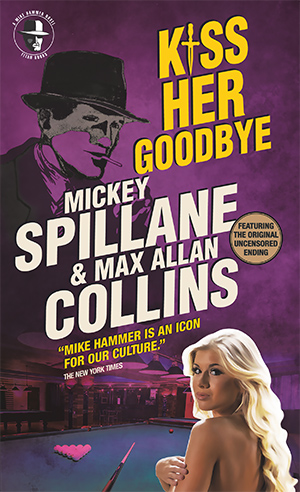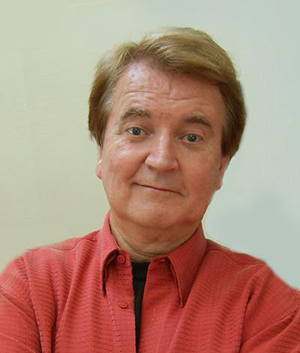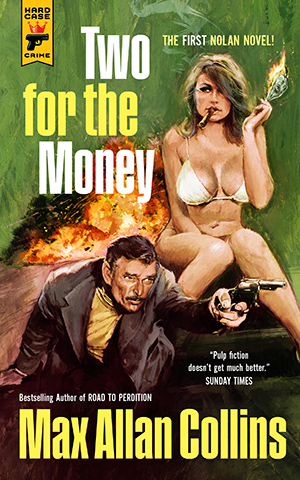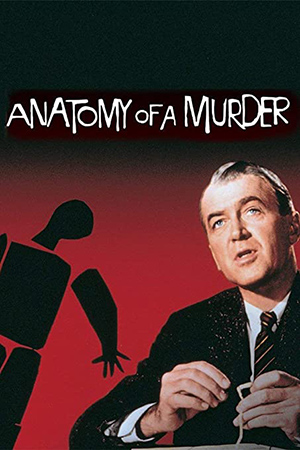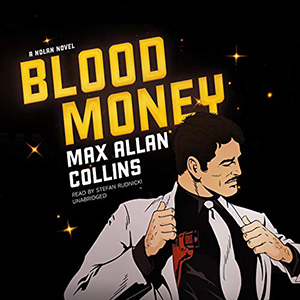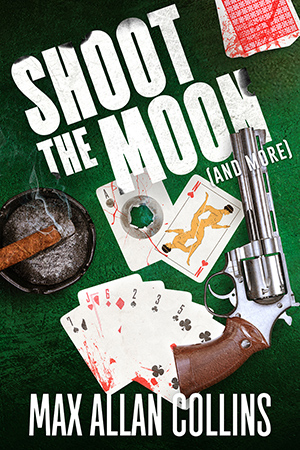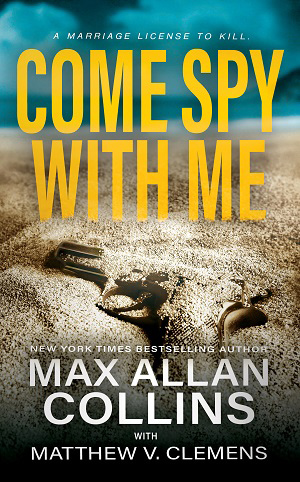Skim Deep should be available by now, the coda to the Nolan series that I’ve written at the urging of Charles Ardai, the guru of Hard Case Crime. It is, as you may know if you’re a regular visitor here, a book in a series I began back in college with my novel Bait Money. That book has been reprinted with its sequel Blood Money as Two for the Money by Hard Case Crime, originally as the first book of mine HCC did, but with an uncharacteristically weak cover, though a new edition from them is coming soon.
 Audible:
Audible: 
An audio book – the first ever – of Bait Money is available now, read by the incredible Stefan Rudnicki.
I’m going to touch on Bait Money again, but first…
Over the holidays I found myself bingeing (usually in four-episode stints) on long-form TV. I have begun to think that long-form television is the new great storytelling art form, more satisfying than most movies and novels. When some unifying artistic force (person or persons) has an overriding vision to control and deploy, the long-form’s depth of character and ability to span time and events can give it appeal, impact and power.
Post-Christmas, I indulged in three true-crime mini-series, all of which made compelling viewing – Manhunt: Unabomber and its follow-up, Manhunt: Deadly Games; and Waco, which leaves Netflix (home of all three) in less than two weeks. I probably liked Deadly Games best, because it opened up the Richard Jewell case more completely than the Clint Eastwood-directed film was able to, and featured a fine performance by Arliss Howard as a crusty ATF bomb expert. Cameron Britton and Jack Huston (as the falsely accused Jewell and real Olympics bomber Eric Rudolph respectively) also were excellent. In Waco, Michael Shannon as the chief negotiator Gary Noesner is typically strong, but Taylor Kitsch’s turn as cult leader David Koresh is a shattering, out-of-left-field career best for the star of TV’s Friday Night Lights and the bewilderingly underrated film John Carter – he makes Koresh human and charismatic without minimizing his madness. No small feat.
All three series, however, share a common problem. They are accurate as to the core true-crime material, but play very fast and loose with fictitious material that surrounds it.
Waco places the Branch Davidian siege’s real-life negotiator at Ruby Ridge, which is not true, and goes out of its way to make the Waco cultists seem reasonable and the FBI unreasonable, when it’s fairly clear that both sides were culpable in the tragedy.
Deadly Games – faithful to the Jewell story – adds a car chase and a bunch of risible material about backwoods redneck militia guys helping track Rudolph and even being led by a young, bossy black female FBI agent; also it has the bomber murdering several people in the woods, which never happened.
The male Unabomber profiler is provided with a love-interest female profiler based on the profiler’s (second) wife, who he hadn’t met yet when the events really happened. In an even more questionable liberty, the profiler – who was largely responsible for identifying the bomber – is placed in a Silence of the Lambs relationship with the perp, sharing numerous scenes, when in fact they never met.
I have to deal with this kind of thing in the Nate Heller novels all the time – balancing the needs of the story against what really happened. It’s not easy to stay true to history without being ruled by it, which is why I employ time compression and composite characters, for example. But TV “true crime” has no compunctions about steam-rolling history.
That may be why, in part, the best long-form mini-series I watched (Barb skipped the others, but watched this one with me) is the wholly fictional The Queen’s Gambit. It’s basically a reworking of The Hustler with chess traded for pool, which is perhaps not surprising because Queen’s Gambit is taken from a novel by Walter Tevis, the author of The Hustler (on which the famous Paul Newman film was based).
Several things make the mini-series work, despite chess being something not every rube knows how to play, and that includes this Iowa rube (Barb, of course, can play chess, though does not claim mastery). The story itself works extremely well – we follow a chess-prodigy orphan girl (taught the game by the orphanage janitor) into her early teens she’s adopted by a couple who live in world out of a Douglas Sirk movie, if that movie were written by Tennessee Williams. The teen evolves into an adult as she climbs to the top of the chess world, one match at a time. The 1950s and 1960s are accurately if acidly depicted, with stellar art direction and a cunning soundtrack of popular music.
But what sells it – beyond the screenwriters and directors making chess games as compelling as any competitive sport, even for a checkers guy like me – is the stunning performance of Anya Taylor-Joy, strikingly beautiful and brilliantly understated in her role, equally convincing as a sheltered teen and worldly young woman, and the various stages between. She also credibly portrays the chess star’s descent into pills and alcohol abuse.
This gave Queen’s Gambit a special resonance to me, and here’s where Bait Money comes back in.
At the University of Iowa, from 1968 to 1970, at the Writers Workshop, I studied with the great mainstream novelist, Richard Yates. I’ve told numerous times the story of how Yates overcame his prejudice against crime/mystery fiction to recognize me as a serious-minded young writer already working at a professional level. Along the way, he became perhaps the key mentor of my writing life.
I would have been content to take all of my classes with Yates, but the program insisted on students experiencing a wider range of instructors. At the Workshop, all of the teachers were respected published authors, which was great, but problematic for a budding mystery writer in the late 1960s. To put things in context, at one point Donald E. Westlake applied for a position – well into his glorious career – and was turned down. Yup, it was a snobby, literary place. Things loosened up some, but when I was there, I was – but for Richard Yates – largely alone on my path.
I was anxious to get through the process and get on with my writing career – even though I hadn’t sold anything yet – and took summer sessions to speed things along. One summer instructor was George Cain, an African American author whose novel about drug addiction, Blueschild Baby, was highly regarded. One day he asked the entirely white class to name their favorite black authors, and the names offered up were predictable (James Baldwin, Ralph Ellison, Richard Wright). Mine were Chester Himes and Willard Motley.
Cain was astonished by these choices, almost offended, and put them both down – Himes didn’t know a thing about the real Harlem, he said, and Motley didn’t count, because he wrote about white people, which made him a sellout. At the time, I didn’t know that Himes had based his Harlem on Cleveland’s Roaring Third Precinct; so I couldn’t defend him, except to say he was a great writer. As for Motley, I said the author was probably just trying to write for a mainstream audience in the ‘40s and ‘50s, the white characters in Knock on Any Door and Let Me No Man Write My Epitaph tackling the same kind of social problems facing African Americans.
Tragically, the talented Cain – who never wrote another book – died of drug addiction himself.
I had several instructors, good ones (Cain included), who were patient with me, despite my insistence on writing crime fiction. Then, in the summer of 1970, I had the opportunity to study with Walter Tevis. I was thrilled. Overjoyed. He was the author of one of my favorite novels! The Hustler was definitely in the hardboiled school, and what a great movie had been made out of it! Obviously Tevis would not share the prejudices toward me and my work that I had sometimes suffered at the Workshop.
And he didn’t. He was a very nice man. As a teacher, he seemed a little lost, and certainly preoccupied. He was, clearly, an alcoholic. He had the sleepy, rumpled manner and bleary eyes that went with it. Often he spoke of his Hollywood experiences and I frankly don’t remember anything else about his classroom approach. Of course, we were young writers in a workshop format and the classes were primarily critique sessions, students talking about each other’s work, the instructor a kind of referee.
 Walter Tevis. Photo credit: E. Martin Jessee/Lexington Herald-Leader
Walter Tevis. Photo credit: E. Martin Jessee/Lexington Herald-LeaderI don’t remember what fiction I submitted that summer. I know that I had completed Bait Money, and that I was continuing my private sessions with Richard Yates, who had helped me get an agent. I was probably working on No Cure for Death. Anyway – I have no memory of how Tevis reacted to any of the student manuscripts we discussed in class.
I recall vividly him speaking of being approached by a Hollywood producer to write a book or film script about poker that would mirror The Hustler. He turned the opportunity down, but said the project became The Cincinnati Kid, about which he was dismissive and resentful. I managed not to tell him that The Cincinnati Kid was a terrific movie, and the book it was based on by Richard Jessup was another favorite of mine. And that I thought he’d made a big mistake not writing a poker version of The Hustler. But now and then I know when to shut up.
Another vivid memory is Tevis being late to class by a good fifteen minutes – we almost walked out, as a group, in his absence – because he’d been on the telephone talking about a movie deal. Someone was thinking about making a film of his novel The Man Who Fell to Earth, he said.
Now, at that time he’d only written two novels. And he admitted to us that he was having trouble writing fiction at all. In fact – and I thought this was very sad at the time, and a little irritating – he put a chapter of a science-fiction book he was trying to write in front of the class, as one of that week’s manuscripts. He wanted to know what we thought about his work-in-progress. I thought we were there so he could tell us what he thought about ours.
Nonetheless, I had bonded somewhat with him, because I’d told him I was a fan, and he was astounded that I had a copy of The Man Who Fell to Earth in its original edition – a Gold Medal paperback – and that I knew The Hustler began as a Playboy short story. We worked out a trade where he gave me a signed copy of a reprint edition of Man Who Fell (from Lancer Books, a minor league company of the day), as he was short copies. I made the trade. Later I found another Gold Medal edition.
The big thing about the summer session was a one-on-one with the instructor. I believe it was a half hour, and I’d been looking forward to it. I had given Tevis the Bait Money manuscript the first day and that’s what we would be discussing. My session with him was toward the end of the summer session – it’s the last time I saw him.
He said, with my manuscript in hand, “I read the first page of your book, and I read the last page. That’s all I needed to read. You’re going to sell it.”
He handed it to me. And that was the session.
Now he may have read more than that, but at the time I was quietly furious. I was driving eighty miles round trip to attend those classes; I was paying good money to attend. And he reads two pages? Hell, in his class, I’d read a whole chapter of his damn science-fiction novel!
On the other hand, he was a pro, and a writer whose work I admired, and he’d looked at my stuff and said I was going to get published – basically, “Don’t worry about it. It’s going to happen.” And, on Christmas eve 1971, it did happen – that’s when the letter came from my agent.
And I do think he may actually have read my whole book. Because his inscription on my signed copy of The Man Who Fell to Earth was: “To Allan – with great hopes for his good book. Walter, July 1970.”
So I had mixed feelings about Walter Tevis. I thought he was a nice, melancholy man with a drinking problem. I always bought his books, including three more science-fiction titles, the first of which didn’t appear till almost a decade later (Mockingbird). Alcoholics Anonymous had been a factor in an early ‘80s comeback, when in a period of about five years he wrote four of his six published novels.
I bought and read the last of these – his unexpected Hustler sequel, The Color of Money, and loved it. Read it in two sittings. I wrote him a letter telling him so, and reminiscing about my experiences as his student, going over much of what I’ve written here, being frank but also appreciative.
I had a stamp on the envelope and the letter was waiting to be mailed when a newspaper told me that Walter Tevis had died. Lung cancer. He’d struggled with a heart condition as well.
My instructor’s novel, The Queen’s Gambit, is – like so many novels by so many of us – a disguised memoir, chess champ Beth Harmon enjoying early success, succumbing to substance abuse, overcoming it, and making a stellar comeback.
As with Skim Deep to Bait Money, there’s a coda to my Walter Tevis story.
Whenever I meet someone famous, I endeavor to find some way I can connect with that person, as a person. With Tom Hanks, at the Chicago Road to Perdition after party, I talked to him about his directorial debut, That Thing You Do, and my having been in a combo much like the one in his film, opening for ‘60s era bands and so on. He lit up. We connected, however briefly.
I took a similar tack meeting Paul Newman at the New York Perdition premiere after party. I should say that of the famous people I’ve met, he was the most intimidating, with the most impenetrable wall up – not unpleasant or nasty in any way, but…he just seemed like a door that had been knocked on too often.
So I mentioned that I studied at the Writers Workshop with the author of The Hustler.
“We threw the whole book out,” Newman said. “Nothing made it into the film. We didn’t use anything.”
Now, I knew this not to be true. The film is a fairly faithful adaptation. So I was flustered. I said something like, “Well, I liked them both very much.”
We spoke a little bit longer, but I was really thrown. Was he sending me a coded message about how unimportant the source writer (me) was to a film like Road to Perdition? Nonetheless, I told him how honored I was to be part of a project of his, and that seemed to please him. We shook hands.
Much later I figured it out. Or anyway I think I did. Newman also starred in The Color of Money (1986), supposedly based on the Tevis sequel to The Hustler. And in that case, the novel really was thrown out, because the Tevis book had a lot to do with the return of Minnesota Fats.
The film version substituted a young pool player, portrayed by Tom Cruise, and the word in the Hollywood trades was that Newman didn’t like working with Jackie Gleason (nominated for an Academy Award for his portrayal of Minnesota Fats), and wouldn’t do the sequel with him in it. And Gleason was too associated with the role to recast, so a new story was written to go with the title of the Tevis book.
The press said Newman claimed he wanted Gleason in as a cameo, and Gleason said he passed after reading scripts that included small scenes with the character that he didn’t feel added to the story. On the other hand, Tevis apparently wrote a faithful adaptation of his book that included Fats as a key player in several senses of the word. The Tevis script was rejected.
In any event, I didn’t care for the film of The Color of Money. It seemed to pander after a young audience via Tom Cruise, and was not one of director Martin Scorcese’s best pictures, and is little talked of today. If you can find the novel, give that a read – it’s very good.
But I have to wonder about that book – did Newman even read the first and last page?
* * *
Here’s a lovely Skim Deep review by Ron Fortier.
Somebody has just discovered the Quarry TV show and likes it.
I made Today’s Word! [I had trouble getting a good link to this (for the time being, it should be the first result at the link above), but I think the newspaper got this from this page at Wordsmith, with some good comments too. — Nate]
Finally, that great podcast Paperback Warrior considers Killing Quarry one of the best ten books the co-host read in 2020.
M.A.C.
